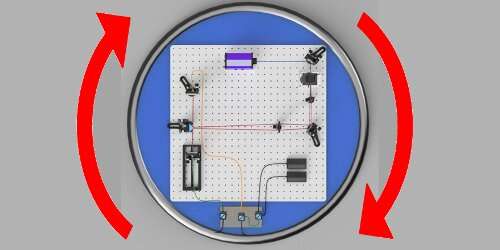A team of researchers from the University of Glasgow and the University of Southampton has devised a novel way to test quantum mechanics in a non-inertial reference frame by using a rotating interferometer. In their paper published in the journal Physical Review Letters, the group describes studying the Hong-Ou-Mandel interference using fiber coils on a rotating disk, and what they found.
As physicists struggle with the problem of uniting general relativity and quantum physics, they devise new ways to test both. In this new effort, the researchers noted that the two theories are consistent under some conditions—such as when gravity is very weak, or when modest acceleration is involved. In their experiment, they chose to test the Hong-Ou-Mandel interference, in which entangled photons are sent on different paths along a circular track—one clockwise, the other counterclockwise. Theory suggests that when such entangled photons are reunited, they should bunch together and move toward one detector or the other. Conversely, non-entangled photons should travel toward either detector randomly.
In their experiment, the researchers set fiber cables on a rotating disk along with sensors for reading where the photons went after passing through the cables. They then sent a stream of entangled photons through the fiber cables (one clockwise, the other counterclockwise) and noted how they behaved as the disk was rotated—a means of applying a non-inertial reference frame. The researchers report that, as expected, the entangled photons did, indeed, bunch up and march off to a sensor together after being reunited with a beam splitter. More importantly, they noted that applying a non-inertial reference frame resulted in one of a pair of photons arriving a little later than the other, which in turn had an impact on the bunching signals the team recorded.
